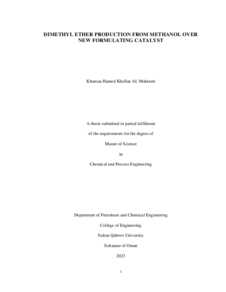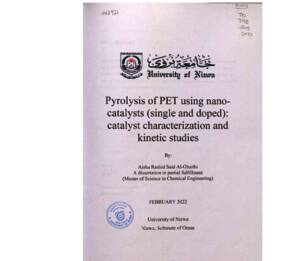Document
Dimethyl ether production from methanol over new formulating catalyst.
Source
Master's thesis
Other titles
إنتاج ثنائي ميثيل الايثر من الميثانول على محفز جديد
Country
Oman
City
Muscat
Publisher
Sultan Qaboos University
Gregorian
2023
Language
English
Subject
Thesis Type
Master's thesis
English abstract
The achievement of the overarching goal of eliminating all greenhouse gas (GHG)
emissions worldwide by the year 2050 requires industry to embrace alternative fuels that
can replace diesel and are environmentally friendly. One such fuel is dimethyl ether. The
main aim of this study is to examine the production of dimethyl ether through the process
of methanol dehydration, using a new formulating catalyst consisting of metal oxide
supported on activated carbon.
The synthesis of the activated carbon catalyst included the use of date seeds, a readily
available and sustainable natural waste resource. The carbonized date seeds were enriched
with metal oxides including molybdate, tungstate, and cobalt, comprising around 4% of
the total composition. A range of analytical techniques, such as X-ray diffraction (XRD),
Fourier-transform infrared spectroscopy (FT-IR), scanning electron microscopy with
energy-dispersive X-ray spectroscopy (SEM/EDS), Brunauer-Emmett-Teller (BET)
analysis, and X-ray photoelectron spectroscopy (XPS), were used to conduct a thorough
characterization of the catalysts that were synthesized. The characterization data obtained
in this study provide prove of the successful impregnation of metal oxides into the
activated carbon substrate. To determine the optimal catalyst for the process of methanol
dehydration, four types of catalysts, namely AC, AC-4% Mo, AC-4% W, and AC-4% Co,
were used in a controlled experimental setting. The results of this investigation suggest
that the catalyst including activated carbon supported by 4% molybdate exhibits enhanced
efficacy in comparison to other catalysts, leading to a higher concentration of dimethyl
ether. The production of dimethyl ether was modelled and optimized using the most
efficient catalyst using response surface methodology (RSM) with the assistance of the
Design Expert program. The investigation included several process parameters, including
temperature (varying from 150 to 250 °C), reaction residence time (ranging from 1 to 3
hr), and catalyst weight (ranging from 1 to 3 g). Based on the 2FI model postulated by
RSM, it was determined that the variable with the most significant impact among the
tested parameters was the process temperature. Increasing in the reaction temperature was
found to be associated with a concomitant elevation in the concentration of dimethyl ether.
The best conditions for dimethyl ether synthesis were determined to be a process
temperature of 249.63 °C, a residence time of 1.00 hr, and a catalyst weight of 1.03 g.
Additionally, a study was undertaken to test the effects of temperatures beyond 250°C on
the synthesis of dimethyl ether, which indicated a decrease in its production beyond this
temperature threshold. While increasing the loading of metal oxide above 4%w/w results
in an enhanced production of dimethyl ether. The results indicate that the most favorable
ratio of metal oxide to activated carbon is 6% w/w. Moreover, the recycled catalysts were
regenerated and used again in methanol dehydration reaction. The evaluation findings
revealed a reaction that may be deemed effective, but with a reduced performance of 73%
when compared to the performance shown by the original catalyst.
Arabic abstract
الرؤية العالمية لتحقيق صفر من انبعاثات الغازات الدفيئة بحلول عام 2050 تحتم على الصناعات التوجه الستخدام أنواع وقود بديلة يمكنها أن تحل محل الديزل و ان تكون وقود صديقة للبيئة مثل ثنائي ميثيل الاثير. تركز الدراسة الحالية على إنتاج ثنائي ميثيل الاثير من خلال عملية تجفيف الميثانول على محفز جديد من الكربون المنش و المدعوم بمعادن مؤكسدة. تم إنشاء محفز الكربون المنشط باستخدام بذور التمر ، وهي مورد مستهلك طبيعي. تم دعم بذور التمر المتفحمة بنسبة ٪4 من أكاسيد المعادن من الموليبدات والتنجستات والكوبالت. تم استخدام تقنيات مختلفة ، مثل XRD و IR-FTو EDS / SEM و BET و XPS ، لتوصيف المحفزات المركبة. أشارت نتائج التوصيف إلى أن أكاسيد المعادن قد تم تشريبها بنجاح في الكربون النشط العادي. تم استخدام الانواع الاربعة من المحفزات) AC ، -4AC٪ Mo ، -4AC٪ W ، و-4AC ٪ Co ) لتجفيف الميثانول في نفس الظروف لتحديد المحفز الاكثر كفاءة. أظهرت النتائج أن الكربون المنشط المدعوم بنسبة ٪4 موليبدات هو المحفز الامثل في هذا البحث ألنه ينتج تركيز أعلى من ثنائي ميثيل الايثر مقارنة بالمحفزات الاخرى. تم تصميم وتحسين إنتاج ثنائي ميثيل الايثر باستخدام المحفز الامثل بواسطة RSM( برنامج Expert Design )بنا ًء على العديد من معامالت التفاعل ، مثل درجة الحرارة )250-150 درجة مئوية( ، ووقت بقاء التفاعل )3-1 ساعات( ، ووزن المحفز ) 3-1 غرام(. اظهرت النتائج ان إنتاج ثنائي ميثيل الايثر بشكل امثل عند درجة حرارة 249.63 درجة مئوية ، ووقت تفاعل 1.00 ساعة ، ووزن محفز 1.03 غرام. بنا ًء على نموذج 2 الذي تنبأ به RSM ، تم تحديد درجة حرارة التفاعل على أنها أكثر المعلمات تأثي ًرا بين المعلمات الاخرى التي تمت دراستها حيث ان تركيز ثنائي ميثيل الاثير يزداد بزيادة درجة حرارة التفاعل . عالوة على ذلك ، تمت دراسة تأثير درجة الحرارة اعلى من 250 درجة مئوية و اظهرت النتائج أن تركيز ثنائي ميثيل الاثير يقل بزيادة درجة الحرارة ألكثر من 250 درجة مئوية. كذلك ت مت دراسة تأثير زيادة نسبة المعدن المؤكسد في المحفز و اكدت النتائج أن نسبة تركيز المعدن المؤكسد %6 هي النسبة الامثل. و في النهاية تم تجديد واختبار المحفزات المتبقية بعد الاستخدام في التفاعل الذي أظهر تفاعلا ناجحا ولكن بأداء أقل من الكحفز الأصلي بنسبة 73%..
Category
Theses and Dissertations


